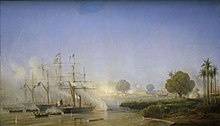Charles Rigault de Genouilly: Difference between revisions
No edit summary |
|||
| Line 17: | Line 17: | ||
[[Image:Prise de Saigon 18 Fevrier 1859 Antoine Morel-Fatio.jpg|thumb|left|The [[Capture of Saigon]], 17 February 1859, a painting by [[Antoine Morel-Fatio]]]] |
[[Image:Prise de Saigon 18 Fevrier 1859 Antoine Morel-Fatio.jpg|thumb|left|The [[Capture of Saigon]], 17 February 1859, a painting by [[Antoine Morel-Fatio]]]] |
||
The expedition was approved, and in early February, leaving ''capitaine de vaisseau'' Thoyon |
The expedition was approved, and in early February, leaving ''capitaine de vaisseau'' Thoyon to sustain the [[Siege of Danang]] with a small French garrison and two gunboats, Rigault de Genouilly sailed south for Saigon. On 17 February 1859, after forcing the river defences and destroying a series of forts and stockades along the Saigon river, the French and Spanish captured Saigon. French marine infantry stormed the enormous [[Citadel of Saigon]], while Filipino troops under Spanish command threw back a Vietnamese counterattack. The allies were not strong enough to hold the citadel, and on 8 March 1859 blew it up and set fire to its rice magazines.<ref>Thomazi, ''La conquête de l'Indochine'', 33–7</ref> |
||
In November 1859 Rigault de Genouilly, whose actions in Cochinchina had come under severe criticism in France, was replaced by Admiral François Page, who was instructed to obtain a treaty protecting the Catholic faith in Vietnam but not to seek any territorial gains.<ref>Tucker, p.29</ref> |
In November 1859 Rigault de Genouilly, whose actions in Cochinchina had come under severe criticism in France, was replaced by Admiral François Page, who was instructed to obtain a treaty protecting the Catholic faith in Vietnam but not to seek any territorial gains.<ref>Tucker, p.29</ref> |
||
Revision as of 03:59, 10 October 2008

Pierre-Louis-Charles Rigault de Genouilly (born April 12, 1807 in Rochefort, died May 4, 1873 in Barcelona) was a nineteenth-century French admiral, chiefly remembered for inaugurating the French conquest of Vietnam.
Early career
Rigault de Genouilly was educated at the Ecole Polytechnique.[1] He entered the navy as an enseigne de vaisseau in 1830, and participated in the French expedition against Algiers. He was promoted lieutenant de vaisseau in 1834, and captaine de vaisseau in 1848. He commanded the first warship to be equipped with a propeller.[2]
Promoted contre-amiral (rear admiral) in 1854, he fought with distinction in the Crimean War, where he was in command of the French marines (fusiliers-marins) during the siege of Sevastopol.
China campaign

In 1856 Rigault de Genouilly was given the command of the French naval division during the China campaign, and occupied the city of Canton.[3]
Cochinchina campaign
In 1858, Rigault de Genouilly attacked Vietnam under the orders of Napoleon III following the failed mission of diplomat Charles de Montigny. His stated mission was to stop the persecution of Catholic missionaries in the country and assure the unimpended propagation of the faith.[4] Rigault de Genouilly, with 14 French gunships, 3,000 men and 300 Filipino troops provided by the Spanish,[5] attacked the port of Danang in 1858, causing significant damages, and occupying the city. After a few months, Rigault had to leave the city due to supply issues and illnesses.[6] Before Rigault de Genouilly, the previous French attack on Danang was the bombardment of Đà Nẵng, handled by Jean-Baptiste Cécille in 1847.
In October 1858, shortly after his capture of Da Nang, Rigault de Genouilly cast around for somewhere else to strike the Vietnamese. Realising that the French garrison at Da Nang was unlikely to achieve anything useful, he weighed up the possibility of action in either Tonkin or Cochinchina. He considered and rejected the possibility of an expedition to Tonkin, which would require a large-scale uprising by the Christians to have any chance of success, and in January 1859 proposed to the navy ministry an expedition against Saigon in Cochinchina, a city of considerable strategic significance as a source of food for the Vietnamese army.

The expedition was approved, and in early February, leaving capitaine de vaisseau Thoyon to sustain the Siege of Danang with a small French garrison and two gunboats, Rigault de Genouilly sailed south for Saigon. On 17 February 1859, after forcing the river defences and destroying a series of forts and stockades along the Saigon river, the French and Spanish captured Saigon. French marine infantry stormed the enormous Citadel of Saigon, while Filipino troops under Spanish command threw back a Vietnamese counterattack. The allies were not strong enough to hold the citadel, and on 8 March 1859 blew it up and set fire to its rice magazines.[7]
In November 1859 Rigault de Genouilly, whose actions in Cochinchina had come under severe criticism in France, was replaced by Admiral François Page, who was instructed to obtain a treaty protecting the Catholic faith in Vietnam but not to seek any territorial gains.[8]
Later career
Rigault de Genouilly returned to France and was Minister of the Navy from 20 January 1867 to 4 September 1870, replacing Justin de Chasseloup-Laubat. He also became Minister of War on August 13, 1869, succeeding Adolphe Niel. He only held the position for a few days, and was replaced by Edmond Le Bœuf on August 21, 1869.
Rigault de Genouilly turned down the offer of command of one of the French fleets during the Franco-Prussian War and retired to Spain to live out his last years. He died in Barcelona in 1873.
See also
Notes
References
- Encyclopedia Britannica Online [3]
- Randier, Jean, 2006, Editions Babouji, ISBN 2352610222
- Tucker, Spencer C (1999) Vietnam University Press of Kentucky ISBN 0813109663
